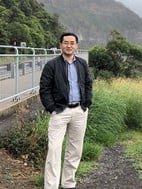Need Help?
1 September 2022
Prof. Dr. Zongyou Yin Appointed Section Editor-in-Chief of Section “Inorganic Crystalline Materials” in Crystals

Prof. Dr. Zongyou Yin obtained his B.S. and M.S. degrees at the Jilin University in China and completed his Ph.D. at the Nanyang Technological University (NTU) in Singapore. Then, he started his postdoc career at NTU/Singapore, the Institute of Materials Research and Engineering (IMRE)/Singapore, followed by the Massachusetts Institute of Technology (MIT). He was also a visiting fellow for one year at Harvard University, USA. Prof. Dr. Yin started a research group at the Australian National University (ANU) in 2017. His group’s research is interdisciplinary, encompassing AI-driven materials innovations, nano-to-atomic materials science, the fundamental relationship among materials–structures–devices, and the synergistic integration of multi-functions towards systems for energy and wearable applications. He has published more than 200 refereed book chapters, articles, and conference proceedings. He has edited one book and filed nine international patents, three of which were converted to PCT patents. Prof. Dr. Yin has been honored as one of the world’s Highly Cited Researchers every year since 2015.
The following is a short Q&A with Prof. Dr. Zongyou Yin, who shared his vision for the journal with us, as well as his views of the research area and open access publishing:
- What appealed to you about the journal that made you want to take on the role as its Section Editor-in-Chief?
I would like to make my contribution to this important research area of the “Inorganic Crystalline Materials” Section. Especially with the introduction of the emerging AI technology to materials science and engineering, the research progress is expected to be accelerated in this area, which might also be an opportunity for this Section’s development.
- What is your vision for the journal?
Under a cooperative endeavor of the whole team, our publications may aim at driving forward active research in the field of Crystals by providing high-quality peer-reviewed research papers through constructive discussion and exchange of ideas across a wide spectrum of scholarly opinions. Our professional platform at Crystals may promote problem-solving research, creating substantial influence for this field.
- What does the future of this field of research look like?
I would think the future of the research in the inorganic crystalline materials field might cover, but not be limited to: 1) AI-aided new functional materials discovery under the high throughput research strategies; 2) multi-levels and multi-components of micro, nano and atomic materials integration for advanced application development; 3) highly accurate but scalable and cost-effective synthesis strategy development for new-generation functional materials.
- What do you think of the development of open access in the publishing field?
Open access (OA) publications eliminate price barriers for readers, e.g., researchers, teachers, journalists, policy makers and even the general public. On the other hand, OA publications are very competitive due to many available OA journals, and most authors might be very careful in selecting OA journals for their publications. Then, how to attract authors' interests and improve publication qualities and, hence, the reputation of our journal is an important task for us.
We wish Prof. Dr. Yin every success in his new position, and we look forward to his contributions to the journal.

